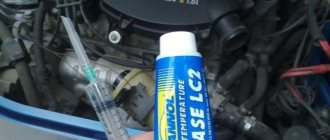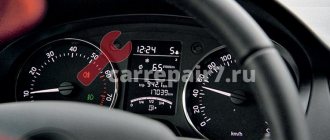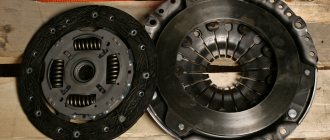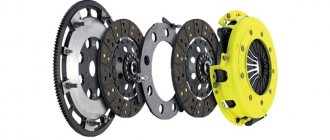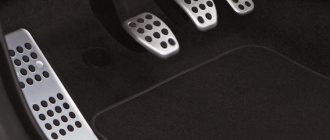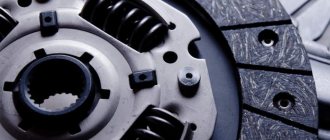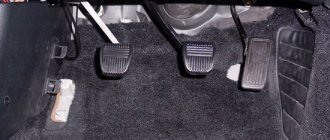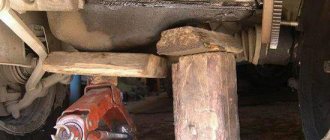The clutch is one of the most important mechanisms in a car. This mechanism ensures that the torque of the car engine is transmitted to the driven disc through the clutch basket. The clutch disc is in constant contact with the flywheel using a spring mechanism. It is affected by the release bearing, the function of which is to disconnect the torque of the motor from the driven disk when you press the pedal. Like all elements of a vehicle, the clutch is subject to wear and various types of problems.
Car owners often do not take into account the existing creaking of the clutch pedal. In fact, this may indicate a number of serious malfunctions. Photo: autoskipper.ru
Solution
In almost all cases, the problem of a squeaking clutch pedal can be eliminated with the help of lubricant. To do this, you need to lubricate all intensively rubbing parts.
Experts recommend using thick grease (CV joint or something like that) as a lubricant. If the car was designed in such a way that it is impossible to get to the pedal elements or spring, do not despair - there is a way out. Use a slotted screwdriver for this. Apply a little lubricant to its metal part, after which you can reach the necessary places with a screwdriver.
There is also a possibility that the squeak does not come from the pedal, but from the clutch fork. During operation, it serves as a place for dirt and used lubricant to accumulate. Because of this, this unpleasant sound appears.
In order to eliminate squeaking in the clutch fork, it must be washed from dirt. Naturally, it is very difficult to reach it, so this must be done through the engine compartment. To clean, you can use carburetor cleaner - it will do the job perfectly. Once you have removed all the accumulated dirt, apply a coat of thick lubricant to the fork.
Other possible squeaks
In addition to the clutch pedal, the reasons for the appearance of squeaks we have already figured out, the reason may lie elsewhere. For example, if the clutch mechanism uses a cable drive, then it is often the cause of unpleasant sounds. If this is the case, simply changing the lubricant will not help solve the problem. To do this, it is necessary to replace the clutch cable.
If you hear a squeak somewhere from the engine, this indicates a faulty release bearing. To fix this problem, you will most likely need to replace the release bearing.
The clutch pedal may make peculiar noises due to the clutch actuator. This is due to the fact that all the work of the clutch is mechanical friction of the working parts. Naturally, the appearance of noise cannot be avoided. In order to get rid of annoying sounds, you will need to periodically lubricate the rubbing parts. Because you will not be able to control a constant level of lubrication - everything is washed off during operation.
There is a more difficult way out of this situation. Using a skilled turner, turn the bushing between the rubbing parts from a softer metal or polycarbonate. In this case, the occurrence of unpleasant sounds will stop, because the friction of different materials will not create such noise as two materials of the same density and structure create.
Many owners of Lada Granta, Kalina and Priora notice the creaking of the clutch pedal. Moreover, this problem may arise after the first kilometers of driving. We will tell you about the possible causes of this disease, as well as ways to solve it.
First, make sure your car's clutch is adjusted correctly. While holding the clutch cable end in an extended position, measure the size between the fork and the driver, it should be 27 mm. How to adjust the clutch cable is shown in the video:
The clutch pedal creaks on a VAZ-2110
The clutch pedal has failed
Car: VAZ-2110. Asked by: Dmitry Aksyonov. The essence of the question: the clutch pedal on the VAZ-2110 began to creak, what should I do?
Damn, bad again! The clutch pedal on the VAZ-2110 began to creak. At first it creaked quietly, but now it’s getting stronger. I looked there in the pedal assembly, tried to lubricate it, but I can’t find where. What to do if the pedal squeaks more and more?
Why does the clutch pedal on a VAZ-2110 squeak?
Experts note that the clutch pedal on the VAZ-2110 is not tight compared to other domestic cars. This is even noticeable when the lubricant on the rubbing parts of the squeezing force transmission dries out.
All my life I have been surrounded by cars! First, in the village, already in the first grade, I was rushing around on a tractor through the fields, then there was JAVA, then a penny. Now I am a third-year student at the Polytechnic Faculty of Automotive Engineering. I work part-time as a car mechanic and help repair cars for all my friends.
Causes
In the diagram, red arrows indicate places where squeaking may occur due to lack of lubrication.
When you drive a car for a long time and do not have it inspected, this will cause the driver to feel discomfort when driving, for example, a creaking sound when pressing the clutch pedal.
Typically, modification and elimination of such a problem is carried out by drilling a larger diameter hole on the shaft attaching the pedal to the body bracket. You can do this yourself
Before work, it is important to find a shaft of suitable diameter that will be placed in the socket. After installing the new shaft, you will need to drip 4-6 drops of oil onto it every day until it breaks in. The oil will get into the gap between the bushing and the bracket, which will prevent the pedal from squeaking when pressed.
Other possible sources of squeaking
The “grandmother” on the bushing may creak.
The clutch cable holder can also be a source of squeaking noise.
Pin for fastening the clutch cable to the pedal.
Lubricating the brake pedal mounting pin.
Lubricate the clutch fork shaft through the side hole.
Lubricating the clutch fork axle through the hole in the plug.
conclusions
After such an event, the pedal will be squeezed easier. This does not require repairing the box. Such modifications can be made not only on the VAZ 2110, but also on other cars of new domestic models.
Recommendations
Comments 25
Now I tried it, it didn’t help (( Granta Drive Active 60,000 mileage
A week later I started clicking again. Not so long ago I was driving a Datsum taxi, it clicks like crazy and I sold it to Grant for fuck's sake
There is an opinion that after such improvement the clutch cable breaks after a certain time. I don’t understand whether it’s a coincidence or not, but my cable broke in this particular place, a couple of months after installing a piece of metal-plastic there. Although I can say in support that there are no more clicks. And at the moment, even the newest one does not crunch))
Crunched up to 47 thousand km. Later, it can crunch and there are no more clicks or crunches. Everything became soft and quiet on its own
Curious... My mileage is 43 thousand km. It was necessary to wait))) for the sake of enthusiasm, I’ll take it out in a month and check it.
I’m not saying anything)) it happened to me personally)) I don’t even understand whether this will happen to you or not)))
There was also such a failure. I changed the spring to a stiffer one. It's been quiet for six months now
Yesterday I set the gap to 27 mm and everything worked. It works unsurpassed
I will inspect the gap and pull it out for testing.
I had enough for a week
A week has passed, everything is ok. I read reviews of people who have been riding for 2 years and everything is ok. You will also need to check the 27mm gap.
I generously lubricated the ratchet mechanism with graphite lubricant from Oilwright. Contributed
Lubricated it didn't help. But it slightly relieved the squeak; after all, the hose does not eliminate the squeak, but eliminates the clicks and gives softness to the pressure because the angle of travel of the cable changes.
This method is not for everyone, it didn’t work for me, I changed the cable to a new one, after 3k the same picture happened again. In the photo, 3 machines click, and the 1st one has an automatic machine.
I read your review. Well, the video helped me. Apparently it works for someone and everything is ok, for someone it doesn’t work and there’s no way to fix it.
Before I got behind the wheel of the Granta, I read the primer for it. The clicking noise is produced by the automatic wear compensator for the disc linings and the cable pull. It clicked once a day for about two weeks, at the moment if it clicks once every six months that’s all. Did not do anything!
I read your commentary before installation. Specifically, clicks and not clicks, I have one now and listen to the video, but earlier everything creaked and clicked. I've been driving for 2 months and it's constantly clicking and from time to time it even feels like the plastic is breaking with a crunching sound being squeezed out. At this point, a week has passed and everything is ok. And one of the main advantages was the soft pedal. We simply change the angle of travel of the cable, but not the most.
My pedal was always soft, there were clicks (on the newest one) once per squeeze. When I worked as a driving instructor, there were also clicks all the time, but one at a time, not the most.
Right now I also have one for the squeeze. Well, I heard it myself.
I set the gap to 27 mm and filled the ratchet mechanism with oil from a syringe and silicone from a balloon. There were no clicks at first, and there was no creaking.
Source: www.drive2.com
Advice!
The clutch pedal should be installed at the level of the other two, otherwise there is a chance that the reverse gear simply will not engage.
If all the manipulations to lubricate all rubbing parts and mechanisms did not help you, and the problem remains unresolved, then in such a situation the best option would be to contact a specialized service center for diagnostic analysis.
Because solving problems with the gearbox and clutch in advance can prevent you from unexpected breakdowns and further expensive repairs.
- For lubricants in hard-to-reach areas, it is best to use WD-40 or a silicone lubricant in spray form. Thus, the material will be better distributed on the surface and will reach all places that are difficult to reach manually.
- It is recommended to lubricate the clutch pedal and fork cable fastenings with graphite lubricant, which has a beneficial effect on such mechanisms and holds well on devices subject to constant load.
Step-by-step instruction
Now we will analyze the whole process step by step. Stock up on a caliper or at least a ruler in advance.
- Open the hood and disconnect the negative terminal on the battery. Now we need to remove the air filter, which hides the components we need
- We remove the mass air flow sensor connector, the adsorber coupler, the rubber supports and tilt the VF housing to the side
- Our clutch fork is located next to the crankcase. On some cars on the secondary market you can also find a sensor moved there by the driver
- Using a tool, say, pliers, we pull the tip towards ourselves in order to free up more space for work
- We take a caliper and measure the distance from the leash to the fork. According to Grant's technical documentation, it should be exactly 27 millimeters
- We adjust the leash according to the thread if the distance does not match
- Then we press the pedal a couple of times, look at the result, and repeat the setting
- Next is the travel of the pedal itself. It should be 14.6 centimeters (+ - centimeter). As already said, it is better if it is flush with the brake
- If even after several adjustments the pedal does not fall into place, then it would be logical to deal with the unit itself
Video - Eliminating crackling and squeaking noises from the clutch pedal
Another source of squeaking may be an insufficiently lubricated input shaft of the box, in the place where the pressure bearing “runs”. This is where it transfers the force received from the clutch fork to the clutch disc. To eliminate squeaking, use a can of graphite lubricant. Lubrication can be done in two ways:
— placing the vehicle on a pit and dismantling the protection of the power unit;
— dismantling the air filter and the clutch fork lever boot.
Squeaks when using the clutch pedal
Why the clutch slips, diagnostics and main faults
As mentioned above, the Lada Granta clutch cable drive has a circuit that provides for the presence of a wear compensator (automatic tensioner). Its participation in the work process significantly simplifies the operation of the vehicle, since it eliminates the need to independently adjust the clutch fork gap or adjust the pedal. However, shortcomings in the production assembly (some of which we mentioned above) reduce the functioning of the wear compensator to nothing.
The solution to the problem involves a complex that includes several, not technically complex, measures:
The initial step is to adjust the clutch fork clearance. This process involves two options:
a) With removal of the air filter housing. We dismantle the (cold) air intake pipe, the air supply pipe to the receiver, and the wiring of the (mass) air flow sensor one by one. We disconnect the electrical harnesses attached to the filter housing, release the housing from the grip of the rubber stops, and then remove it.b) Without removing the air filter. This method is less common because it requires quite a lot of effort to perform manipulations in the limited space of the engine compartment.
To set the clutch fork gap to 27 millimeters, we perform the following manipulations. Pull the clutch cable all the way (in the direction of vehicle movement) and by twisting (unscrewing) the plastic “lamb”, set the required gap (L) between it and the fork.
The next stage (after setting the working gap on the fork) of a set of measures to eliminate the causes of extraneous noise during operation of the clutch pedal will be lubrication of the elements of the pedal assembly. As a lubricant, experts recommend using a substance that is extremely popular among car enthusiasts - WD-40. Lubricant is supplied not only to the clutch bushing, but also to the plastic ratchet that compensates for wear. Applying lubricant to the cable sheath won't hurt either.
In addition to the information presented above, let's look at a few more reasons that cause squeaking clutch pedals.
One of these reasons may be the friction of the plastic bushing, which is one of the parts of the pedal mechanism, on the bracket. This happens when the pedal is pressed on the microswitch of the mechanism that automatically tensions the clutch cable.
Answers (3)
- Lubricate the clutch pedal cable, or change the cable itself. Or do nothing. My pedal squeaked on my Opel. I sprayed WD-40, but it didn't help for long.
08/07/2019 at 13:20
- Lubricate these places on the clutch pedal assembly with lithium grease - look at the photo
08/07/2019 at 13:42
- What helps is to place a piece of hose under the cable. Only 5-6 cm of hose. There is one in the photo.
Where to put the hose
Space for hose08/07/2019 at 13:45
Similar questions
Causes of these unpleasant sounds from the car
Oddly enough, the reason for these clicks is one design feature of the VAZ gearbox clutch drive. Namely, the self-regulation mechanism of the tensioner. It is shown in the photo below.
Parts No. 3 and 4 are visible here. Part No. 3 is a rod clamp for fixing No. 4. According to the designers, when the pedal is activated, this rod should slightly lift the cable and fix it in one position on the pedal. However, this, alas, does not happen. But this “tandem” regularly produces loud, unpleasant clicks that get on the nerves of the car driver. When you need to use the clutch, this sound is extremely annoying.
Advertisements on NN.RU – Auto
Extend the chassis (frame) on Gazelle Next, Gazelle peasant under a body of 4.2 m, 5.1 m and 6.2 m. Extend the frame on Gazelle Next, Gazelle Gas 3302. Cost: 25,000 rubles.
A wide selection of hydraulic pumps and hydraulic motors of all series: spline hydraulic pump of right rotation. It is used in road construction and... Cost: 1,000 rub.
A special enterprise for the conversion of cargo vehicles produces extensions of the man man, iveco iveco truck tractor.
A special enterprise for converting cargo vehicles into a tow truck invites you to install a tow platform on.
Source: www.nn.ru
How is the cable constructed?
You can see the condition of the cable through the hood. Despite the simplicity of the element, in fact it is a whole structure consisting of several elements. Moreover, it is equipped with automation. We need to bypass it in order to adjust the cable ourselves.
What do we see? There is a coupling from which the shell comes out on one side and the leash on the other. A thin end of the cable, enclosed in a corrugated tube, is stretched to the leash. The tip going into the fork is hidden under it. We need to tighten it up or change it completely. It is the source of those very extraneous sounds.
By rotating the leash, you twist or twist it, correcting the gap. This is how manual length adjustment occurs. Note that the shorter the cable, the sharper the pedal will respond to pressure. Ideally, it should rise exactly to the level of the brake pedal. At the same time, we check whether it clicks when pressed.
Consequences
This operation does not cause any negative consequences. As the clutch discs wear, the rod will gradually come back out. However, when new clicks begin, the time will come to change the clutch itself.
The design of the Priora clutch drive cable can be seen in the video:
- Vehicle track width: determine correctly
- Homemade strobe for setting the ignition
- How to make a car strobe light with your own hands
- Vehicle understeer and oversteer
Diagnosis of typical main faults
In order to switch gears in the gearbox when accelerating or, conversely, when decreasing it, each time the engine crankshaft is disconnected and again comes into contact with the vehicle’s power transmission. This happens very often, and over time, signs of clutch wear begin to appear in the way the car behaves on the road while driving.
Signs of clutch failure are divided into two main groups. The first is when it does not completely turn off, it “leads”. The second, on the contrary, when it does not turn on completely, or, as they say, “slips.”
Article on the topic: Polishing car headlights with toothpaste - is it worth it or not?
The clutch does not disengage (“drive”)
When the discs do not move completely apart when you press the pedal, they say the clutch is “driving.” That is, the disks remain in some contact, and it does not turn off completely. Experienced drivers know how to check the clutch for incomplete disengagement. Diagnosis is simple. If at low speeds with the pedal pressed all the way, first gear is engaged easily and without extraneous noise, the shutdown occurs completely. If switching occurs with difficulty and is accompanied by gear noise, it “drives.”
The reasons for this may be:
a) mechanical
- the driven disk linings are broken or the rivets on them are loose;
- decrease in full pedal travel (tight clutch);
- the driven disk is warped and its end runout exceeds 0.5 mm;
- the pressure plate is warped or warped;
- the hub of the driven disk jams on the splines of the input shaft in the gearbox;
- the rivets securing the pressure spring are loose;
- irregularities have formed on the surface of the friction linings of the driven disk.
b) associated with hydraulic drive
- fluid leakage from the hydraulic system;
- air has entered the system.
Elimination of mechanical causes involves adjusting the drive, cleaning and lubricating the splines, straightening or replacing the driven disk and, most often, replacing the friction linings. Every clutch has to be replaced at some point. Problems in the hydraulic system require bleeding to remove trapped air, checking the tightness of connections and the integrity of the pipeline. If necessary, you will have to replace failed parts, such as the main and working cylinders if fluid leaks from them.
Article on the topic: How to remove the alternator belt tensioner and replace it
Does not turn on (“slips”)
When, while driving, you begin to smell a burning smell, and on a climb your car noticeably slows down and generally begins to accelerate worse, you don’t even need diagnostics: the clutch is slipping. This means that the driven and driven discs do not close tightly enough when the clutch is engaged. There is an easy way to check the clutch. To do this, put the car on the parking brake and start the engine. Squeeze the clutch and engage the gear. Smoothly press the gas pedal and just as smoothly release the clutch. The engine should stall. If it continues to work, it means the clutch is slipping.
Reasons for incomplete inclusion:
- there is no free play of the pedal;
- the friction linings of the driven disk are burnt or worn out;
- oil has got or continues to get on the friction linings, on the surface of the pressure plate and flywheel.
These reasons can also be eliminated by adjusting the drive and replacing the linings. Oil that gets on the rubbing surfaces, which results in a slipping clutch, must be removed by thoroughly washing the contaminated areas with white alcohol. Of course, it is necessary to find out and eliminate the reason for its appearance.
Features of the Lada Priora clutch
Any motorist interested in how to adjust the clutch on a Priora should know about the presence of the drive cable auto-adjustment function. That is, VAZ designers took care of the owner and saved him from the need to constantly adjust the clutch drive mechanism during operation. The same ratchet-type system is installed on Kalina, but both there and on Priora it is impossible to do without periodic adjustments. This factor has been proven by practice and forum discussion pages.
How does an automatic cable tensioner work?
In the release drive on the VAZ 2170, there are no gaps as a concept, hence the name - backlash-free clutch. The ratchet mechanism serves to compensate for the working length of the cable as the driven disk linings wear out
To understand the process, it is important to accept the following data:
- During operation, the driven disk wears out and its linings become thinner - as a result, the release bearing and basket springs shift towards the gearbox.
- Accordingly, the fork at the place where the cable is attached moves towards the radiator.
- The spring located on the bushing of the adjusting mechanism is compressed at this time and tightens the clamps of the cable tip.
- As a result, the tip is pulled out of the driver, due to which the wear of the disc linings is compensated.
For those who don’t yet know how to adjust the clutch on a Priora themselves, it is important to take into account the moment when the linings are new. In this case, when releasing the pedal, the ratchet bushing will only lightly touch the bracket without releasing the clamps
Therefore, the toothed tip of the cable will not move relative to the housing. Only as the linings wear out does the spacer sleeve release the spring-loaded clamps and the cable tip extends to the amount necessary to balance the worn parts.
In what cases is it recommended to contact a service station?
Unfortunately, not only squeaking occurs, but also serious problems, among which the most unpleasant and difficult to fix is clutch slipping, which is not uncommon for this model. In such a situation, the only way out would be a visit to the service station. On average, a clutch kit will cost 5 thousand rubles, plus 1-2 thousand rubles. – installation fee.
A visit to a service station can be avoided if you properly care for the transmission and follow the recommendations of experts:
- If possible, do not overstress the clutch. Try to move off gently at a low crankshaft speed (watch the tachometer readings). Otherwise, due to natural inertia, slippage with accelerated wear will occur.
- Do not release the pedal too slowly, as if on a truck: do not be afraid - the car will not stall. Modern cars with synchronizer are equipped with systems that do not involve, for example, double squeezing with re-throttle. In general, feel free to take your foot off the pedal. What was useful in Soviet times is now harmful, and light pressure leads to unwanted slippage and a reduction in resource.
- Do not tow other vehicles when driving uphill. This is especially harmful on slippery, uneven roads.
- Do not hold the clutch in the depressed position, but remove your foot from the pedal, placing the lever in neutral. This loads the box, but spares the clutch.
Thus, how long the clutch will last and how often it will be disturbed during operation depends only on you. Remember: any malfunction can be easily fixed in a timely manner. And if you don’t have the appropriate skills, it’s better not to get down to business, but entrust the responsible mission to professionals.
What to do?
A question that torments every car owner, but everyone has their own problem. If we talk about creaking, then you need to understand what further operation will lead to. If it seems that when you press the pedal the fork will break, then it is better to carefully drive to a car service center and give the car to specialists. If everything is fine with the pedal, it works as always, then you can drive until everything becomes obvious.
What should you do yourself? If the car owner knows the design of his car, then it will not be difficult for him to get to the clutch on his own and figure out the problem. But the problem could also be in the pedal. It is this that a person constantly acts on, so it is worth checking the return mechanism, or rather, looking at the condition of the spring. Fortunately, there is a lot of space in the Hyundai Solaris and anyone can do it.
The clutch pedal on all cars weighs on a bracket and is mounted on an axle. Inside they have plastic bushings that can provide easy pedal travel. Often these are the ones that wear out.
It’s worth noting that they are plastic, so you shouldn’t lubricate them, it won’t help anyway. They need to be changed immediately.
To eliminate light squeaks that do not affect the forks or cable, you just need to unharness the spring and remove the entire pedal unit. While all this is in this state, you can take the opportunity to lubricate the pedal. The only problem may be that the creaking appears most often in winter, and the procedure can take quite a long time. But it’s better than hearing this creak when pressed. If you don’t want to do this, then, of course, you can try to lubricate the bushings. However, it is not certain that this will help.
If, which is quite logical, the creaking remains and has not even lost its volume, then you need to look for the reason in the return spring, and it can creak on its own. Lubricating or dripping WD-40 is not a good idea. Not worth the word “at all”. It is best to use a CV joint; such lubricant is sold in tubes, which is very convenient. Experts say that this eliminates squeaking in 99 cases out of 100.
List of online stores selling parts (Moscow, St. Petersburg, Kyiv regions)
| № | Name | Address |
| 1. | "Autoall" | www.avtoall.ru |
| 2. | "Original part" | lada-original.ru/ |
| 3. | "Navigator" | www.navigator-63.ru/ |
| 4. | "TOTAX" | totax.com.ua |
| 5. | "Zakupka" | kiev.zakupka.com |
| 6. | "How much" | www.avtostore.spb.ru |
